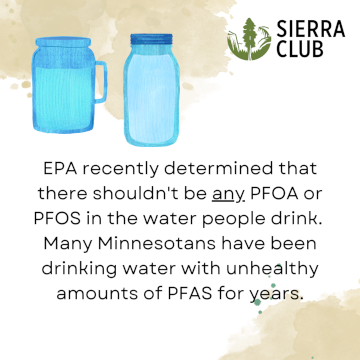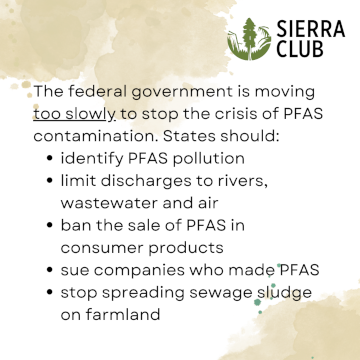EPA’s new assessment reveals new risks of PFAS-contaminated drinking water - thousands of people drinking water now considered to be unsafe
 In June, the Environmental Protection Agency (EPA) announced a dramatic revision to its drinking water limits for four toxic PFAS chemicals. The agency is lowering its lifetime health advisory levels for two chemicals - PFOS and PFOA - by more than 1000-fold to just 20 and 4 parts per quadrillion, respectively. We reviewed recent drinking water test data by the state of Minnesota and found that more than 2.9 million Minnesotans have detectable concentrations of PFAS in their water system, more than 1.5 million of whom are drinking water that exceeds EPA’s health advisory levels for PFOS or PFOA.
In June, the Environmental Protection Agency (EPA) announced a dramatic revision to its drinking water limits for four toxic PFAS chemicals. The agency is lowering its lifetime health advisory levels for two chemicals - PFOS and PFOA - by more than 1000-fold to just 20 and 4 parts per quadrillion, respectively. We reviewed recent drinking water test data by the state of Minnesota and found that more than 2.9 million Minnesotans have detectable concentrations of PFAS in their water system, more than 1.5 million of whom are drinking water that exceeds EPA’s health advisory levels for PFOS or PFOA.
PFAS are per- and poly-fluoroalkyl substances, a family of man-made chemicals used in a wide variety of consumer and industrial products, and produced at 3M’s Cottage Grove facility among other sites.
EPA’s new health advisory limits stem from a re-evaluation of the science for PFOS and PFOA, particularly recent evidence that low levels of exposure can have long-term impacts on children’s immune systems, and can affect cardiovascular health, pregnancy outcomes, and cause cancer. EPA also set new limits for PFBS and GenX, two chemicals developed by industry as “safer replacements” for PFOA and PFOS. The new drinking water advisory levels of 10 and 2,000 parts per trillion respectively indicate that PFBS and GenX are also harmful and should not be used in commerce. E
Sierra Club reviewed drinking water test data from the Minnesota Department of Health (MDH) and identified 60 public drinking water systems with PFOS or PFOA levels that exceed EPA’s new advisory level. Concentrations of these chemicals were 40- to more than 1000- times the new EPA advisory limits. Five of these systems also have maximum water levels that exceed the legal limit in Massachusetts, the state that regulates the greatest number of PFAS chemicals, allowing no more than 20 parts per trillion of six PFAS chemicals. In addition to these, many Minnesota water systems have notable concentrations of PFBA, a chemical developed and used at the 3M facility in Cottage Grove.
Since the testing data MDH posts online is undated, it isn’t immediately apparent if people drinking water from these systems are still ingesting potentially harmful concentrations of PFAS chemicals. The state of Minnesota has been gauging water safety based on its own advisory values for PFOA, PFOS, and four other PFAS chemicals. But the values are now dangerously out of date. Minnesota must alert people whose drinking water exceeds the new federal advisory levels, as residents are unaware of the fact that they may have been ingesting water with harmful amounts of two PFAS chemicals for years if not decades.
26 Minnesota drinking water systems with highest concern for PFAS chemicals* (all values in parts per trillion)
|
Water system name |
Water system id (PWSID) |
PFOA+PFOS |
Sum of 6 PFAS** |
PFBA |
Total PFAS |
|
Hastings |
1190012 |
25 |
32 |
490 |
625 |
|
Woodbury |
1820025 |
23 |
30 |
280 |
388 |
|
Cottage Grove |
1820004 |
16 |
41 |
860 |
1,067 |
|
Austin Mobile Home Park |
1500003 |
15 |
21 |
4 |
77 |
|
Maple Grove, Corcoran and Osseso |
1270020 1270075 1270042 |
1 |
16 |
21 |
70 |
|
Apple Valley |
1190001 |
10 |
15 |
47 |
90 |
|
Mobile Manor Mobile Home Park |
1700010 |
9.9 |
11 |
10 |
49 |
|
Robbinsdale |
1270046 |
9.7 |
15 |
14 |
55 |
|
Stillwater |
1820024 |
8.7 |
17 |
120 |
171 |
|
Cloquet and Scanlon |
1090005 1090011 |
7.5 |
14 |
5.6 |
43 |
|
Becker |
1710008 |
7.4 |
8.6 |
15 |
49 |
|
Richmond |
1730022 |
6.6 |
9.7 |
7.4 |
52 |
|
North Saint Paul |
1620011 |
5.6 |
8.0 |
63 |
93 |
|
Shakopee |
1700009 |
5.5 |
8.6 |
36 |
90 |
|
Alexandria |
1210001 |
5.5 |
14 |
4.5 |
48 |
|
Bay Lake Reserve Development |
1820036 |
5.0 |
5.0 |
210 |
225 |
|
Cimarron Park |
1820010 |
5.0 |
5.0 |
140 |
159 |
|
Brooklyn Park |
1270005 |
4.2 |
12 |
30 |
63 |
|
Oakdale |
1820016 |
4.0 |
6.0 |
1500 |
1,581 |
|
Terrace Heights MHP LLC |
1620018 |
2.3 |
2.3 |
180 |
196 |
|
Roosevelt Court |
1040035 |
2.3 |
36 |
1.3 |
78 |
|
Newport |
1820014 |
350 |
367 |
||
|
Eagle's Watch Development |
1820034 |
290 |
300 |
* These systems have PFOS+PFOA levels greater than 5 ppt, and the sum of six key PFAS is greater than 10 ppt, total PFAS levels greater than 100 ppt
** PFAS6 are the six chemicals regulated in Massachusetts, the state with the broadest number of regulated chemicals. Massachusetts sets a legal limit of no more than 20 parts per trillion for the sum of PFOA, PFOS, PFHxS, PFHpA, PFNA and PFDA
About the data - These records were downloaded from the Minnesota Department of Health in early July. The date of sampling isn’t listed in this online system. People may drink water that has been treated or blended to reduce PFAS levels.
PFAS - the “forever chemicals” pose long-term and expensive risks to Minnesotans
PFAS chemicals are known as “forever chemicals” due to the fact that they never break down in the environment and continue to accumulate in our bodies over time. They are widely used in fabrics, food packaging, rugs, cleaning products, make-up and greases or waxes, and common household products like Teflon. But the pollution caused by making or using these products containing PFAS chemicals also impacts water sources for millions of Americans.
Our analysis is based on an on-going sampling effort by the state of Minnesota Department of Health. Results to date include 106 of the 966 Community Water Systems operating in the state. Due to differences in system size, Minnesota estimates that only 36.48% of state residents have PFAS testing data available for the water they drink. Testing is voluntary and there is no data for some counties with closed landfills that have contaminated groundwater at levels that exceed MDH drinking water guidance values. People drinking water from private wells are also at risk.
Many more Minnesota residents could be impacted by potentially harmful concentrations of PFOS or PFOA, because EPA’s new drinking water advisory levels are set below the concentrations that can be currently measured in drinking water. Also, state-based testing often excludes people drinking water from private wells. Minnesota has sampled water for just a handful of more common PFAS chemicals, but hundreds of other chemicals in the PFAS family are widely used yet unmeasured and unregulated in drinking water.
To protect water, states must limit PFAS use
 Compared to many other states, Minnesota has made admirable progress in surveying the extent of PFAS contamination of drinking water, surface water, fish and polluted sites.
Compared to many other states, Minnesota has made admirable progress in surveying the extent of PFAS contamination of drinking water, surface water, fish and polluted sites.
Minnesota has received a multi-million dollar settlement with 3M for pollution in the East Metro and allocated money to clean-up and provide water filtration for people living in the impacted area. The state is studying the impact of PFAS in wastewater and banning the chemicals in food packaging, but it must redouble efforts to curtail PFAS discharges into the wastewater, landfills, and the air.
Luckily, some states are already taking action to address the source of the PFAS pollution by limiting the use of PFAS in fire fighting foam, banning the use of PFAS in consumer products and setting guidelines for waste disposal. These and other steps will keep more PFAS from entering the water system, and we need all 50 states to take action now for the health and safety of all people in this country.